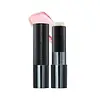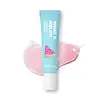What's inside
What's inside
 Key Ingredients
Key Ingredients

 Benefits
Benefits

 Concerns
Concerns

 Ingredients Side-by-side
Ingredients Side-by-side

Diisostearyl Malate
EmollientCaprylic/Capric Triglyceride
MaskingPolyglyceryl-2 Isostearate
EmulsifyingHydrogenated Polyisobutene
EmollientOctyldodecanol
EmollientButyrospermum Parkii Butter
Skin ConditioningMicrocrystalline Wax
Emulsion StabilisingPolyethylene
AbrasiveCeresin
Emulsion Stabilising1,2-Hexanediol
Skin ConditioningEthylhexylglycerin
Skin ConditioningPhenoxyethanol
PreservativeGlycerin
HumectantTocopheryl Acetate
AntioxidantRosa Canina Fruit Oil
EmollientPrunus Armeniaca Kernel Oil
MaskingPersea Gratissima Oil
Skin ConditioningMacadamia Ternifolia Seed Oil
EmollientButylene Glycol
HumectantWater
Skin ConditioningPropylene Glycol
HumectantHydrogenated Lecithin
EmulsifyingCeramide NP
Skin ConditioningAnemarrhena Asphodeloides Root Extract
Skin ConditioningCI 45410
Cosmetic ColorantParfum
MaskingDiisostearyl Malate, Caprylic/Capric Triglyceride, Polyglyceryl-2 Isostearate, Hydrogenated Polyisobutene, Octyldodecanol, Butyrospermum Parkii Butter, Microcrystalline Wax, Polyethylene, Ceresin, 1,2-Hexanediol, Ethylhexylglycerin, Phenoxyethanol, Glycerin, Tocopheryl Acetate, Rosa Canina Fruit Oil, Prunus Armeniaca Kernel Oil, Persea Gratissima Oil, Macadamia Ternifolia Seed Oil, Butylene Glycol, Water, Propylene Glycol, Hydrogenated Lecithin, Ceramide NP, Anemarrhena Asphodeloides Root Extract, CI 45410, Parfum
Polyisobutene
Hydrogenated Polyisobutene
EmollientBeeswax
Emulsion StabilisingMicrocrystalline Wax
Emulsion StabilisingMethyl Hydrogenated Rosinate
PerfumingPanthenol
Skin ConditioningCeramide NP
Skin ConditioningCitrullus Lanatus Fruit Extract
Skin ConditioningMel Extract
MoisturisingPropolis Extract
Skin ConditioningHoney Extract
HumectantSimmondsia Chinensis Seed Oil
EmollientArgania Spinosa Kernel Oil
EmollientAdansonia Digitata Seed Oil
EmollientHelianthus Annuus Seed Oil
EmollientMoringa Oleifera Seed Oil
EmollientVanilla Planifolia Fruit Extract
Skin ConditioningMacadamia Ternifolia Seed Oil
EmollientTriticum Vulgare Germ Oil
EmollientMangifera Indica Seed Butter
Skin ConditioningTocopherol
AntioxidantElaeis Guineensis Kernel Oil
EmollientParfum
MaskingCI 75470
Cosmetic ColorantPolyisobutene, Hydrogenated Polyisobutene, Beeswax, Microcrystalline Wax, Methyl Hydrogenated Rosinate, Panthenol, Ceramide NP, Citrullus Lanatus Fruit Extract, Mel Extract, Propolis Extract, Honey Extract, Simmondsia Chinensis Seed Oil, Argania Spinosa Kernel Oil, Adansonia Digitata Seed Oil, Helianthus Annuus Seed Oil, Moringa Oleifera Seed Oil, Vanilla Planifolia Fruit Extract, Macadamia Ternifolia Seed Oil, Triticum Vulgare Germ Oil, Mangifera Indica Seed Butter, Tocopherol, Elaeis Guineensis Kernel Oil, Parfum, CI 75470
Ingredients Explained
These ingredients are found in both products.
Ingredients higher up in an ingredient list are typically present in a larger amount.
Ceramide NP is a type of ceramide.
Ceramides are intercellular lipids naturally found in our skin that bonds dead skin cells together to create a barrier. They are known for their ability to hold water and thus are a great ingredient for dry skin.
Ceramides are an important building block for our skin barrier. A stronger barrier helps the skin look more firm and hydrated. By bolstering the skin ceramides act as a barrier against irritating ingredients. This can help with inflammation as well.
If you would like to eat ceramides, sweet potatoes contain a small amount.
Read more about other common types of ceramides here:
Ceramide AP
Ceramide EOP
Hydrogenated Polyisobutene is a synthetic polymer. Polymers are compounds with high molecular weight. Hydrogenated Polyisobutene is an emollient and texture enhancer.
In one study, Hydrogenated Polyisobutene showed better skin hydration levels than Caprylic/Capric Triglyceride. As an emollient, it helps keep your skin soft and hydrated by trapping moisture in.
Hydrogenated Polyisobutene is often used as a mineral oil replacement.
Learn more about Hydrogenated PolyisobuteneMacadamia Ternifolia Seed Oil is the fixed oil obtained from Macadamia nut.
Macadamia seed oil is rich in fatty acids, including oleic acid (45-75%), palmitoleic acid (7-33%), and palmitic acid (6-12%). They also contain various B vitamins, iron, and magnesium.
Palmitoleic acid has been shown to help soothe inflammation and promote wound healing. It is also naturally found in the fat of our skin.
Macadamia seed oil may not be malassezia folliculitis, or fungal-acne, safe.
Learn more about Macadamia Ternifolia Seed OilMicrocrystalline Wax is created by de-oiling petroleum. It is highly refined and purified before being added to cosmetics.
Microcrystalline Wax is used to enhance the texture and create even consistency. It helps stabilize a product by preventing ingredients from separating.
Parfum is a catch-all term for an ingredient or more that is used to give a scent to products.
Also called "fragrance", this ingredient can be a blend of hundreds of chemicals or plant oils. This means every product with "fragrance" or "parfum" in the ingredients list is a different mixture.
For instance, Habanolide is a proprietary trade name for a specific aroma chemical. When used as a fragrance ingredient in cosmetics, most aroma chemicals fall under the broad labeling category of “FRAGRANCE” or “PARFUM” according to EU and US regulations.
The term 'parfum' or 'fragrance' is not regulated in many countries. In many cases, it is up to the brand to define this term.
For instance, many brands choose to label themselves as "fragrance-free" because they are not using synthetic fragrances. However, their products may still contain ingredients such as essential oils that are considered a fragrance by INCI standards.
One example is Calendula flower extract. Calendula is an essential oil that still imparts a scent or 'fragrance'.
Depending on the blend, the ingredients in the mixture can cause allergies and sensitivities on the skin. Some ingredients that are known EU allergens include linalool and citronellol.
Parfum can also be used to mask or cover an unpleasant scent.
The bottom line is: not all fragrances/parfum/ingredients are created equally. If you are worried about fragrances, we recommend taking a closer look at an ingredient. And of course, we always recommend speaking with a professional.
Learn more about Parfum